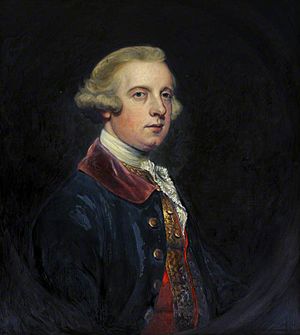Lord John Cavendish facts for kids
Quick facts for kids
Lord John Cavendish
|
|
|---|---|
 |
|
| Chancellor of the Exchequer | |
| In office 2 April 1783 – 19 December 1783 |
|
| Monarch | George III |
| Prime Minister | The Duke of Portland |
| Preceded by | William Pitt the Younger |
| Succeeded by | William Pitt the Younger |
| In office 27 March 1782 – 10 July 1782 |
|
| Monarch | George III |
| Prime Minister | The Marquess of Rockingham |
| Preceded by | Lord North |
| Succeeded by | William Pitt the Younger |
| Personal details | |
| Born | 22 October 1732 |
| Died | 18 December 1796 (aged 64) |
| Resting place | Derby Cathedral |
| Nationality | British |
| Political party | Whig |
Lord John Cavendish (born October 22, 1732 – died December 18, 1796) was an important British nobleman and politician. He was known for being a very honest and talented person. He served as a top financial minister for Britain twice.
Early Life and Family
John Cavendish was the youngest son of William Cavendish, 3rd Duke of Devonshire. His mother was Catherine Hoskins. His older brothers included William Cavendish, 4th Duke of Devonshire, who became a Prime Minister.
John Cavendish went to Newcome's School in Hackney, London. He also studied at Peterhouse, Cambridge University.
Political Career
Lord John Cavendish was a member of the House of Commons. He held a very important job called Chancellor of the Exchequer. This person is in charge of the country's money and finances. He served in this role twice: first in 1782, and again in 1783.
In 1782, he also became a member of the Privy Council. This was a group of trusted advisors to the King.
He was a strong supporter of Lord Rockingham, a leading politician of the time. Later, he supported a group called the Fox-North Coalition. This group helped the Duke of Portland become Prime Minister.
In 1784, when the coalition lost power, Lord John Cavendish lost his seat in Parliament. He did not return to the House of Commons until 1794. He then represented the area of Derbyshire, which was a traditional seat for his family.
Life and Legacy
Lord John Cavendish lived at Billing Hall in Northamptonshire. He asked a famous architect, John Carr, to update his house in a popular style around 1776. The house later went to another family in 1790.
He never married and passed away in December 1796, at the age of 64.
After his death, his friend Edmund Burke, a famous writer and politician, spoke highly of him. Burke said that Cavendish had a very honest and honorable mind. He described him as kind, friendly, and generous. Burke also mentioned that Cavendish was very intelligent and well-educated. He believed Cavendish served the public with loyalty and courage.
Another writer, Sir Nathaniel Wraxall, also wrote about Lord John Cavendish. Wraxall noted that people always listened to Cavendish with respect. He said that Cavendish's family name was linked to important events in British history, like the Revolution of 1688, which protected people's freedoms. Wraxall also said that honesty was clearly visible on Cavendish's face.
Images for kids


